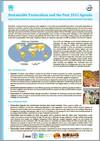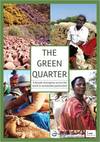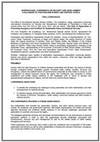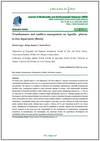The Post-2015 Agenda provides an opportunity to work globally towards making livestock production systems more sustainable while finding solutions for the conservation and sustainable use of ecosystems such as rangelands. This fact sheet presents overlooked facts, myths and emerging issues regarding pastoralism and gives recommendations on how to work towards sustainable pastoralism.
Year of publication: 2014Organization: International Union for Conservation of Nature (IUCN), United Nations Environment Programme (UNEP)
Topic: Economy, Environmental services, Participation
Language: English
Type of document: Technical
Geographical coverage: Global
What is the magnitude of pastoralism? The issue of the social and economic importance of pastoral systems is closely related with policies of land use. Overestimating the importance of pastoral systems, or downplaying it, can slow down development and lead to undesirable consequences. This study looks at the demand, the supply, and the future concerning data on the magnitude of pastoral systems in Kenya.
Year of publication: 2014Organization: Drylands Learning and Capacity Building Initiative for Improved Policy and Practice in the Horn of Africa (DLCI), Individual authors
Topic: Economy
Language: English
Type of document: Scientific
Geographical coverage: Eastern Africa
The World Initiative for Sustainable Pastoralism (WISP) has now been in existence for a decade, a period during which considerable progress has been made globally towards sustainable pastoral development. Many challenges remain for pastoralists, but in the areas where gains have been made it is vital these are built upon and achievements are not squandered. This book follows WISP’s global approach and highlights key examples from its work with partners around the world. It identifies the impact of WISP’s work in empowering pastoralists through improved advocacy skills and better knowledge, and in helping to change policy and practice. Through case studies, testimonies and photos, this book aims to bring WISP’s global stories of pastoralism to a wider audience and identify opportunities for future success.
Year of publication: 2014Organization: International Union for Conservation of Nature (IUCN)
Topic: Climate change, Economy, Environmental services, Resilience
Language: English, Français
Type of document: Technical
Geographical coverage: Global
Key stakeholders that included the pastoralists, farmers, and other natural resource users, civil society, the academia, key government agencies, faith-based organizations, the media and security agencies discussed and proffered lasting solutions to the security challenges associated with pastoralism in countries and across the region, to promote the improvement of pastoral production systems.
Year of publication: 2014Organization: Individual authors
Topic: Conflict, Organization
Language: English
Type of document: Policies and legislation
Geographical coverage: West Africa, Central Africa
The country report presents an analysis of changing policy narratives about the arid and semi-arid lands in Kenya. Kenya cannot achieve its development targets unless there are appropriate investments in the arid and semi-arid lands. These lands can make a significant contribution to national development and the failure to integrate them into the national economy is perhaps being the main reason for the failure of national development since independence. Investing in the arid lands is now a constitutional imperative and the institutional foundations for their integration into national development are now in place.
Year of publication: 2014Organization: International Institute for Environment and Development (IIED)
Topic: Climate change, Economy, Environmental services, Resilience
Language: English
Type of document: Technical
Geographical coverage: Eastern Africa
The substantial value of pastoral systems remains largely invisible to local, national and regional calculations of economic performance (for example the construction of GDP). Official data continue to be used even when their reliability is known to be poor. A complementary framework in cost-benefit analysis, known as Total Economic Valuation, is increasingly being used by NGOs and regional bodies to help put onto the map the many aspects of economic value contributed by pastoral systems– contributions that are presently not counted. This issue paper provides a practical tool for those interested in carrying out work on the Total Economic Valuation of pastoralism.
Year of publication: 2014Organization: International Institute for Environment and Development (IIED)
Topic: Economy
Language: English
Type of document: Technical
Geographical coverage: Eastern Africa, Global
For thirty years, Agonlin region in Zou department has been subject to extensive movements of national and cross-border transhumance every year: it is a seasonal movement of flocks and their shepherds in search of water and pastures. The absence or weakness of structures and hospitality infrastructure, especially transhumance corridors lead transhumant animals to cause enormous damage to farmers with immeasurable drawbacks (destruction of crop fields and fallows, cattle raiding crops , raping women, slaughtering animals, etc.)
Year of publication: 2014Organization: Individual authors
Topic: Conflict, Indigenous peoples, Organization
Language: English
Type of document: Technical, Scientific
Geographical coverage: West Africa
Vulnerability and poverty levels remain stubbornly high and arguably are deepening in many pastoral areas of the Horn of Africa. This is in spite of galloping livestock commercialisation
in these areas and their closer incorporation into wider systems of marketing, trade and
investment. The fact remains that the benefits of recent growth and investment in pastoral areas have yet to result in wider benefits for addressing food insecurity and poor nutrition. Thus, strengthening social protection systems in the region is a prerequisite for realising more inclusive growth at the pastoral margins.
This brief details the role of social protection in agendas to promote agricultural growth, highlighting areas of innovative programme design and implementation where further efforts might focus.
Year of publication: 2014Organization: Future Agricultures Consortium
Topic: Economy, Food security, Gender and youth, Indigenous peoples, Social services
Language: English
Type of document: Technical
Geographical coverage: Eastern Africa









